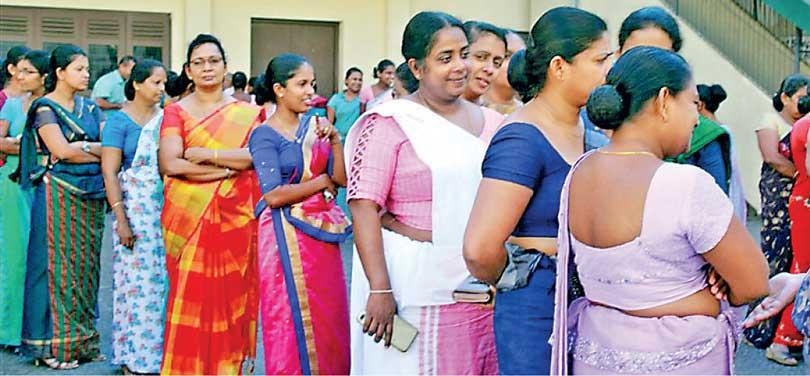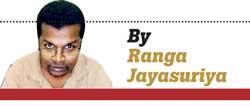29 Nov 2022 - {{hitsCtrl.values.hits}}

Although there was a furore over female teachers' attire, the government is firm that they are clad in sarees while in schools.
 Recently, a rather unusual and indeed needless debate hobbled the country’s schools after a group of teachers ditched their sarees, the standard attire for female teachers in public schools, in favour of more comforting clothing of their choice to attend the schools. They were acting per a government circular that relaxed the dress code for public servants during the Covid-19 pandemic.
Recently, a rather unusual and indeed needless debate hobbled the country’s schools after a group of teachers ditched their sarees, the standard attire for female teachers in public schools, in favour of more comforting clothing of their choice to attend the schools. They were acting per a government circular that relaxed the dress code for public servants during the Covid-19 pandemic.
However, the gesture of defiance by a small number of female teachers attracted a predictable reaction from the usual culprits. A group of regime-affiliated Buddhist monks deduced a foreign plot to alter the cultural ethos. Some government ministers alleged a well-funded NGO campaign behind the move, and certain lowlifes flooded social media with sexual innuendoes.
Meanwhile, the supporters of the teachers’ move challenged the critics to wear the saree for five days and decide for themselves. It is not clear whether the request to change the attire had the support of a majority of teachers, though the Ceylon Teachers Union championed the demand. In the end, the government decided to revoke the circular, which should put the issue to rest now. The government may be right to stick to Saree.
Uniforms and dress codes provide a semblance of uniformity across the profession and are a representation of organizational ethos and professional esteem. For the teachers, it is a representation of one’s ‘self’ as educators and the uniformity and unity within the schools. Sri Lanka is not the only country where teachers are expected to wear standard attire, and the choice of saree represents the desire to root the education system in the traditional cultural ethos and values.
However, this is the least of the problems that beset Sri Lankan schools at the moment. Twin shocks of the Covid-19 and the current economic crisis have battered the education system. As findings of other countries reveal, Covid-19 infused school closures have a severe impact on the learning achievements of children, especially of those from lower income brackets. Sri Lanka has not done any yet.
Sri Lanka’s higher education priorities are lopsided and come at the expense of the vast majority of its children and youth. The government investment in education and training of 70% of students who fail to go to a public university is paltry
Sri Lanka prides itself on free education, which indeed has been a great driver of equality and social mobility. However, access to free education has not been equal, and recent developments have widened the gap.
According to a study by the Institute of Policy Studies, based on the 2016 Household Income and Expenditure Survey of the Department of Census and Statistics, 4.7% of poor kids left school between the ages of 5 and 14, compared to 0.7% for kids from non-poor households.
By the age of 17-18, -i.e. after the Ordinary level exam - around 64.3% of poor kids drop out compared to 30.3% for kids from non-poor households, according to the author Wimal Nanayakkara.
Also, vast disparities exist in the public education system, between the better-off urban schools, and resource-scarce rural and provincial schools. Inequality in access and resources in effect fosters inequality of outcome of learning.
For instance, the national assessment of students in grade 8 (2016) found vast disparities in the performance of their students in Mathematics, Science and English across the provinces and different school types. Disparities were equally high among students in all three subjects. For instance, in mathematics, while 25% of students scored above 70%, another 32% scored less than 40.
National results were not impressive either; the mean score for Mathematics was 51.1%, science, 41.76 % and English 35.81%
How these results compare with the international peers is not known. More industrious nations have opted to take part in international assessment programmes such as PISA. The latter for instance measures the performance of 15 years old in mathematics, science and reading. In these tests, students of Vietnam outperform their richer peers in Germany. The absence of international comparison also fosters a degree of complacency and inertia. There is only a slight increase in overall student performance over the years as measured by local assessment tests.
Sri Lanka can borrow the best practices of high achievers, such as Singapore or China’s Shanghai, in modernizing its teaching methodologies and curriculum in mathematics and science. It would also help Sri Lanka to take part in international comparative assessment programmes to have an idea of its comparative position.
An equally important concern is the fate of school dropouts. According to the recently released results of the Ordinary level examination, 74.5% of students who sat for the exam qualified to pursue the Advanced level. The remainder who drops out would be left with fewer vocational and educational opportunities. Policy-making in Sri Lanka has placed little attention on this segment of less fortunate youth, who are also from poor families, effectively forcing them into a life of everyday drudgery. It is hard for a nation to rise when one-fourth of its children are discarded on the first go.
The Advanced level examination set off another hurdle that is insurmountable even those who passed it; for instance, 171,497 students or 62.9% of students, who sat for the Advanced level examination, qualified for university admission. However, until, 2020, only 30,000 students, or 10% of those who sat for the Advanced level exam were admitted to the university. The intake was expected to increase by 10,000, however, the financial strains have left it in limbo.
Sri Lanka’s higher education priorities are lopsided and come at the expense of the vast majority of its children and youth. The government investment in education and training of 70% of students who fail to go to a public university is paltry. The vested interested groups, the inter-university student’s federation being the most disruptive of all, have done as much harm to their less fortunate peers as Velupillai Prabhakaran did to the Tamil youth. Destructive campaigning by the university student activist has scuttled any commonsensical programme to provide the majority of students with affordable higher education opportunities with the participation of the private sector.
This unequal status quo, maintained through the threat of protests and public disruption is callous and destructive. A determined government should be able to forge ahead with a national programme to provide equitable and affordable higher education for all of the nation’s children.
The final outcome of this insalubrious status quo and disparities in the system is that despite the great expectations, much of the promise of free education is squandered, worst still, by the selfish interest of those who better off themselves through free education.
How much of the potential of free education is unfulfilled could be found in Sri Lankans heading for foreign jobs, often unskilled or semi-skilled ones in the Middle East and Korea. Some misconstrue this as brain drain. No, this is in fact, how Sri Lanka releases its demographic pressure by exporting its surplus human labour, a generation of youth who are left behind by the system.
The government should break this insidious cycle and confront the vested interests that perpetuate the unequal status quo so that the nation’s children could achieve their full potential. That is more important than what female teachers wear to school.
Follow Ranga Jayasuriya
@Rangajayasuriya on Twitter
25 Dec 2024 8 hours ago
25 Dec 2024 9 hours ago
25 Dec 2024 9 hours ago